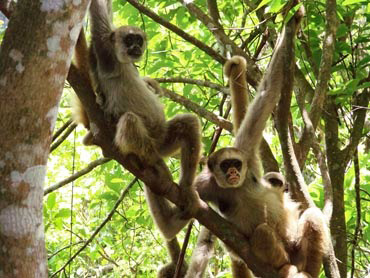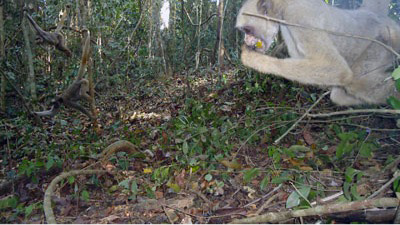Apparent recovery of endangered muriqui monkeys in Brazil may not tell the whole story
On paper, the northern muriquis (Brachyteles hypoxanthus) look like a conservation comeback story. Three decades ago, only 60 of the gentle, tree-dwelling primates lived in a fragment of the Atlantic Forest along the eastern coast of Brazil. Now there are more than 300.
But numbers don’t tell the whole story, according to anthropologist Karen Strier and theoretical ecologist Anthony Ives of the University of Wisconsin, Madison. The pair analyzed 28 years of data on the demographics of the muriquis, one of the longest studies of its kind. They found surprising patterns about birth and death rates, sex ratios, and even how often the monkeys venture out of their trees. These findings raise questions about the muriquis’ long-term survival and how best to protect them, the scientists wrote in the Sept 17 issue of PLoS ONE.
 Northern muriqui monkeys from a wild population in the Brazilian Atlantic Forest are pictured in 2008. University of Wisconsin-Madison anthropologist Karen Strier has devoted the past 28 years to studying these critically endangered monkeys. Photo credit: courtesy of Carla B. Possamai/Universidade Federal de Espirito Santo |
Although the population of muriquis is growing, their territory is not. The monkeys inhabit a 957-hectare forest (about 2,360 acres) hemmed in by coffee plantations and family farms. Despite the advantages of living on private land—the Reserva Particular do Patrimonio Natural Feliciano Miguel Abdala, in Minas Gerais—they still face one of the most important problems in conservation biology: habitat fragmentation.
Usually, when populations increase and resources become limited, females don’t produce as many offspring, said Ives in an interview with mongabay.com. But muriqui females have had more babies, caused by shorter time spans between births.
In another surprising result, more muriqui males in their prime died as the population grew. Most growing populations have higher mortality rates for younger and older males who can’t compete as well. “But the opposite happened with the muriquis,” Ives said.
Their sex ratio switched, too. At the beginning of the study, two-thirds of the muriquis were female; at the end, two-thirds were male. Other population studies have shown similar reversals, Strier said. Although the reason isn’t clear, the consequences to an endangered population are obvious: fewer females produce a smaller population.
Beyond the statistical surprises, the muriquis also changed their behavior. Typically arboreal, the monkeys started spending more time on the ground. Strier thinks this vertical move might have driven the unexpected increases in fertility and mortality rates. Foraging at ground level may provide more nutritious food, enabling healthier females to reproduce more quickly. Coming down from the trees also may expose more male monkeys to dangerous predators, she said.
The study shows that even though the population is growing, it isn’t safe, Strier told mongabay.com. “It’s not just numbers, it’s dynamics,” she said.
“The work is remarkable,” said Anthony Rylands, deputy chair of the IUCN SSC Primate Specialist Group in Arlington, Va. “Ideally, you’d like to compare to similar studies, and there really aren’t any.”
 A new study reports increasing use of the ground among a population of the otherwise arboreal northern muriqui monkeys in Brazil. Researchers led by University of Wisconsin–Madison anthropologist Karen Strier believe the behavioral innovation may underlie demographic changes in the population over the past 30 years, including unexpected increases in both fertility and mortality. Photo credit: Karen Strier, University of Wisconsin–Madison |
In spite of the unusual results, the overall picture is good: the population is growing, said William Morris, a plant conservation biologist at Uppsala University in Sweden. “But it’s like a stock portfolio. Past performance is no guarantee of future performance,” Morris told mongabay.com. “That’s a good message for keeping an eye on the conservation of rare populations.”
Strier plans to continue monitoring the muriquis, with a focus on why the females are now more fertile. The key to their future is expanding their forest range to support the population growth, she said. Corridors to link their Atlantic Forest fragments have been under development for several years.
What’s more, the muriqui is a candidate to become the mascot for the 2016 Summer Olympic Games. Their celebrity status, perhaps, could help their conservation.
CITATION: Strier K and Ives A (2012) Unexpected Demography in the Recovery of an Endangered Primate Population. PLoS ONE. 7(9):e44407. doi:10.1371/ journal.pone.0044407
Elizabeth Devitt is a graduate student in the Science Communication Program at the University of California, Santa Cruz.
Related articles














